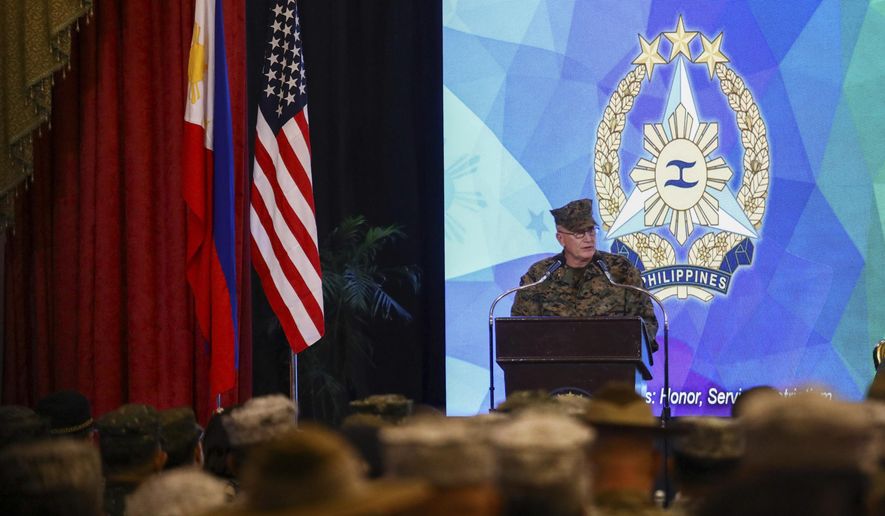A version of this story appeared in the daily Threat Status newsletter from The Washington Times. Click here to receive Threat Status delivered directly to your inbox each weekday.
SEOUL, South Korea — The U.S. and the Philippines kicked off joint military drills Monday in the South China Sea, drawing immediate protests from China.
The drills began on the same day that a four-day, high-level naval symposium got underway in the Chinese port city of Qingdao, offering senior officers from the U.S. and its allies the rare opportunity to discuss efforts to ease regional tensions directly with their Chinese and Russian counterparts.
The annual drill, Balikatan (“Shoulder-to-Shoulder”) is set to run through May 10, with more than 16,000 troops undertaking drilling a range of capabilities, including cyber and information warfare, maritime security and air defense. In addition to the American and Philippines units, smaller contingents of Australian and French troops will join the drills, and officers from India and Japan, part of the U.S.-led “Quad” of Asian democracies, will observe the maneuvers.
This year’s drill takes place not only in Philippine waters, but in the international waters of the South China Sea, which China claims at its own territory, and which it has massively fortified with a range of air and naval bases.
Clashing sovereignty claims in the strategically vital sea have led to a string of maritime clashes west of the Philippines between Chinese and Philippine Coast Guards and fishing vessels from both nations.
U.S. Marine Lt. Gen. William Jurney told reporters that the exercises will demonstrate that the 1951 U.S.-Philippines mutual defense treaty “is no mere piece of paper.”
“We’re dead serious about protecting our territory — that’s why we do these Balikatan exercises,” Philippine military spokesperson Col. Michael Logico, told The Associated Press.
The exercises follow a first-ever trilateral summit, held in Washington, among President Biden, Japanese Prime Minister Fumio Kishida and Philippine President Ferdinand Marcos Jr.
Mr. Marcos has reversed the pro-China lean of his predecessor, Rodrigo Duterte, and enhanced defense ties with the Biden administration. The Pentagon last year secured additional basing rights in the island nation, including in northern Luzon, the area that overlooks the strategic Bashi Channel between the Philippines and Thailand.
The U.S. has also recently deployed its Typhoon midrange missile system to Luzon. That system can launch both Tomahawk cruise missiles and the RIM-174 Standard Extended Range Active Missile, a multiuse, two-stage projectile is capable of both air defense and high-speed anti-ship strikes.
That capability could feasibly, in the event of hostilities, deny the Bashi Channel to Chinese naval forces. That, in turn, would be a considerable handicap if Chinese forces ever sought to blockade or surround Taiwan.
China has repeatedly condemned the growing Washington-Manila alliance.
“Drawing in countries outside the South China Sea to flex their muscles and stoke confrontation in the region will only intensify tensions and undermine regional stability,” Chinese Foreign Ministry spokesperson Lin Jian said on Monday, according to the Chinese media outlet ECNS.
Despite the tensions, China is also hosting a four-day, regional maritime security symposium in Qingdao, a port city in the Yellow Sea.
Among those attending the 19th Western Pacific Maritime Symposium are naval officers from Australia, Britain, China, India, France, Japan, Russia, and the U.S. The U.S. is represented by Pacific Fleet Commander, Adm. Stephen Koehler.
China’s second most senior officer, Deputy Chairman of the Central Military Commission Admiral Zhang Youxia, spoke at the meeting of China’s willingness to cooperate with other navies, but added, “Reality has shown that those who make deliberate provocations, stoke tensions, or support one side against another for selfish gains will ultimately only hurt themselves.”
Themes of the symposium include how to avoid accidental clashes during unexpected encounters at sea. It is also expected to address the emerging domain of seaborne drones. The biennial event was last hosted by Japan in 2022.
The Qingdao meeting follows the resurrection of long-dormant deconfliction talks between Chinese and U.S. officers. Early this month, Chinese naval officers met their U.S. counterparts in Hawaii.
The talks had been suspended by Beijing following then-House Speaker Nancy Pelosi’s visit to Taiwan in 2002, which infuriated China.
• Andrew Salmon can be reached at asalmon@washingtontimes.com.




Please read our comment policy before commenting.